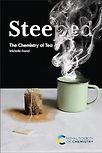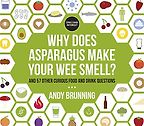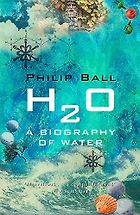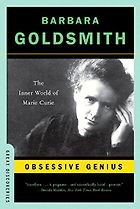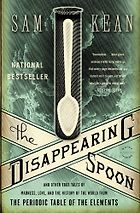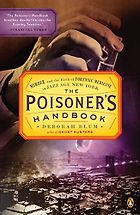The physicist Richard Feynman said that if in some cataclysm all scientific knowledge were to be destroyed, and only one sentence passed on to the next generation, the statement that would contain the most information in the fewest words would be ‘all things are made of atoms.’ I guess this is the heart of chemistry, or close to it. What more do we need to know about chemistry?
Feynman’s advice reminds me of Isaac Asimov’s story, ‘Nightfall,’ where the stars only appear once every few millennia, the sight drives everyone mad, the world burns and science must begin all over again while the scientists attempt to preserve enough information to jump start the process the next cycle! Chemists certainly see the elements, atoms, as the building blocks of the universe. We are interested in the structure of matter, what atoms make up a molecule or other, more complex material, and how are they connected to one another. We come up with new methods to see inside of matter.
Since the function of a molecule depends on its structure, it is critical to understand what a chemical will do. We are also interested in how one molecule turns into another, and how we can control that transformation to make new molecules. To do that, we work on an incredibly small scale. Atoms are tiny. There are billions more atoms in a teaspoon of water than there are stars in the Milky Way. But I would push back against Feynman and say that chemists are interested in uncovering the patterns in these transformations of matter, and that awareness of the reproducibility of chemical reactions came well before we knew about atoms, and opened the door to a lot of key discoveries. The first chemists were brewers, dye makers, painters and cooks.
Your research is not very like brewing or cooking. Can you tell us something about what you study, and what you love in your work?
You’re quite right, I don’t work in the classic chemistry lab with bubbling flasks and beakers—instead, I grab a cup of tea and log into a supercomputer, or find a handy blackboard. I’m a quantum chemist who develops and uses theoretical methods to understand the structure of molecules—the locations of the atoms in space, and more critically, why certain molecular structures arise. One of the primary tenets of chemistry is that molecular structure determines molecular behavior, so understanding a molecule’s structure is key to understanding a molecule’s function.
The molecules that interest me most are the ones that misbehave, or rather, that have structures that chemists believe they shouldn’t. The molecules, of course, don’t know the rules the chemists think they should follow, so these structures offer clues to new paradigms. I love the moment when I can figure out what the molecule is doing, and suggest new ways for chemists to think about molecular structure. Right now my research group and I are exploring molecules that have weird topological properties, like Möbius strips, and as a result, have unexpected structures. From here, we hope to give chemists who synthesize molecules in the lab some ideas about new classes of structures with interesting properties.
It sounds as if simple curiosity plays an important role in your research, but you and your funders are surely also interested in its potential applications.
Curiosity and delight definitely play a big role in my choice of interesting research problems. But working on these sorts of problems also drives the other part of my research, which is the development of mathematical and computational methods to help chemists sort out what’s happening beneath the surface. The methods I’ve developed are now part of the standard suite of tools that quantum chemists have to probe molecules and have been applied to a wide variety of practical problems, including helping design new drugs to control blood pressure and to understand how taxol, a potent anti-cancer drug, works.
How do you assess the significance of the work that has won the 2018 Nobel Prize in Chemistry?
First off, I should say that Smith, Winter and Arnold’s work is very far from my own field. I’m not a biochemist. That said, my biochemistry colleagues were very excited to see more recognition for this strategy for making proteins that can make molecules ‘to order’, and the practical possibilities are truly endless. I’ll also say that having written an essay, ‘Sex in the Citadel of Science’ about why it might be that, even as the number of women in chemistry grew, women won fewer and fewer Nobel prizes in chemistry, I was delighted to see Frances Arnold win. And it was excellent to see Donna Strickland, whose work is probably closer to my field than this year’s chemistry laureates, among this year’s winners of the Physics prize.
Let’s turn to your first book choice. Tell us about Philip Ball’s H2O: A Biography of Water.
A few years ago I attended a workshop at the Vatican Observatory on water in the solar system, and started to wonder exactly how old the water in my tea cup was. Was it here from earth’s formation, or did it crash land on a craggy ball of dust sometime later? I wrote “A brief history of water in the universe” for Nature Chemistry, and in doing the research for that, encountered Philip Ball’s biography of water.
Some years ago I had assigned Ball’s Designing the Molecular World to my introductory chemistry course along with the more usual thousand-page textbook, in part because I wanted them to appreciate the beauty and excitement of chemical research. H2O didn’t disappoint me. Ball talks about tough scientific topics in ways that are both accurate and truly accessible.
Water is such an iconic molecule, and such a ubiquitous one. It’s in the clouds and the oceans; it runs in our veins, and is tucked into the inner spaces of our cellular machinery. Ball tells its story with sharp science and thought provoking imagery. One image that has really stuck with me is that we shouldn’t think of clouds as discrete entities, like cotton puffs floating above the earth, but rather see them as processes, like waterfalls, ever changing. The chapter on weird water wanders through not just the odder stories (and fictions) about water, but has something deeper to say about the line between science and pseudoscience that we would all do well to heed in this era of “fake news”.
Your second choice is Barbara Goldsmith’s Obsessive Genius: The Inner World of Marie Curie. One reviewer wrote that one of the book’s strengths is its suppression of anger. Do you agree? What are some of its other strengths?
I don’t know if I agree that Goldsmith suppresses all of the anger a twenty-first century feminist might feel about the way Marie Curie was treated by the broader scientific community. In describing the manoeuvring around Curie’s Nobel prize, for example, Goldsmith notes “a vicious sexism ripped away all pretense that Marie Curie might be accepted as an equal”, and proceeds to detail with a cold clarity all the ways in which Curie’s contributions were diminished. It isn’t a casual cultural sexism that Goldsmith describes, but a determined attempt to cast Marie as an assistant and muse, rather than as a scientist in her own right, by those with direct evidence to the contrary.
I read Eve Curie’s biography of her mother as an impressionable nine year-old, which left me with a romanticized view of her genius and a deep desire to become a scientist, like Marie. To me, the strength of Goldsmith’s biography of Marie Curie is how it so clearly characterizes the depth of her obsession with her scholarly work in the face of almost unimaginable difficulties, from her struggles to afford her education in Paris to the loss of her beloved Pierre. Perhaps the book’s greatest strength is that Goldsmith does not gloss over Curie’s struggles with debilitating depression, one episode of which kept her from going to Stockholm to receive her first Nobel prize, and which occurred at intervals throughout her life. Nor does she downplay Curie’s flagrant disregard of the hazards of working with radioactive materials. I’m still inspired by Curie, but now as much by her persistence through her mental illness as by her discoveries.
Your third choice is The Disappearing Spoon by Sam Kean. Please give us an idea of why you like this book…and explain the title!
Sam Kean brings the periodic table to life with the stories you didn’t hear in high school chemistry but will wish you did. Kean explains why tin screams when you bend it and what that has to do with Robert Scott’s disastrous trip to the South Pole (spoiler, it’s a phase change, like the melting of ice) and how cesium is used as an atomic clock. Every page is an adventure, showcasing the breadth of properties and behaviors of the elements. I’ve been a chemist for forty years and this book really captures what I love about chemistry – both its surprises and its predictability. Along the way, Kean clues you in to the mysteries of the periodic table, where it came from and how it is organized.
As to the title, if you make a spoon from pure gallium, it looks and feels much like a stainless steel spoon, but if you use it to stir your tea, it will seem to vanish before your eyes. It is literally melting, gallium’s melting point is only 86°F (30°C) and if you pour out the tea you’ll find a pool of silvery liquid gallium at the bottom. There’s a cool video of it online! Sam Kean uses the story of the disappearing spoon to launch the story of the bitter clash between Dmitri Mendeleev, who is credited with developing the periodic table, and Paul Lacoq de Boisbaudran, who discovered gallium.
With your fourth choice, Deborah Blum’s The Poisoner’s Handbook, we are in the territory of true crime. Why do you recommend this book?
I straight-up love mystery novels—particularly ones that turn on the details of physical evidence. Deborah Blum’s book reminds me that molecules are powerful witnesses, if only we have the skills to interrogate them, and sometimes they are killers. The Poisoner’s Handbook is organized around the career of Charles Norris, a pathologist and the medical examiner for New York City in the early twentieth century, and Alexander Gettler, a chemist with expertise in toxicology, but the molecules and the methods Norris and Gettler use to detect them are the primary characters.
The tales are gritty, and Blum doesn’t stint on the gory details. The stories of cyanide poisoning are not for the weak-stomached or faint of heart. My favorite vignettes are where the chemistry doesn’t convict the obvious suspect. Frank Travia, accused in late 1926 of killing his girlfriend, and then dismembering her body to dispose of it, insisted that he’d woken up to find her dead on the floor. The case went to trial, but Norris and Gettler were able to show that the real culprit was carbon monoxide from Travia’s stove. As Blum so vividly puts it, “Carbon monoxide is a kind of chemical thug. It suffocates its victims by simply muscling oxygen out of the way.”
“Carbon monoxide is a kind of chemical thug. It suffocates its victims by simply muscling oxygen out of the way.”
Blum’s last story is the most captivating. Imagine a tasteless, odorless poison that easily dissolves in coffee or tea, kills its victims with less than a third of an ounce, and unlike carbon monoxide or cyanide poisoning leaves no gross evidence on autopsy. Could a poisoner using thallium get away with murder? No, Blum reassures us: the clue is in the name of the element. William Crookes discovered thallium when he observed a bright spring green color in a flame test of contaminated sulfuric acid. Gettler would burn samples of victim’s tissues and look for that characteristic green. The incident that Blum recounts that most horrified me was not a murder at all. Crookes apparently ingested thallium in an attempt to prove to his rival for the discovery, Claude-August Lamy, that it was safe, at least in low doses, and thereby discredit Lamy.
Your final choice is Why Does Asparagus Make Your Wee Smell? by Andy Brunning. Why does it, and what else does Brunning tell us?
To start, Andy Brunning points out that not everyone’s does—only people who can break down asparagusic acid, a chemical that is found only in asparagus, will notice the effect. The products of that breakdown are simple sulfur molecules, including methyl mercaptan, the same compound that is added to natural gas to give it a smell to alert people to leaks. Sulfur compounds are notoriously smelly. Even in incredibly tiny amounts, humans can detect their odors at the parts per billion level, so it doesn’t take much asparagus to be able to detect these compounds in your urine.
The focus Brunning has on molecular structure through this book is very much in tune with my own research on molecular shape and behavior. Brunning takes us on a molecular tour of what we eat and drink, breaking down the structures of molecules and their reactions to explain why bacon tastes so good and brussel sprouts so awful, at least to those whose are genetically predisposed to tasting the bitter thiocyanates in the latter. He uses bold graphics to show what the molecules look like, giving us a taste of how chemists see the world. Tucked into each vignette is an easily digestible chemistry lesson, from what techniques are used to identify those smelly molecules in urine (gas chromatography) to the quantum mechanics behind why a gin and tonic will glow under a black light (the quinine in the tonic).
Five Books interviews are expensive to produce. If you're enjoying this interview, please support us by donating a small amount.
This book reminds us that humans are small chemical factories, taking in raw materials, turning them into energy and building materials and producing wastes, some of them smellier or more colorful than others.(What beets can do to your wee is startling). But Brunning also reminds us that we use molecules for pleasure—from the way the menthol in mint binds to the receptors for “cool” in the mouth, tricking us into thinking we’re eating something cold, to the sharp bitterness of the phenylindanes that give a mid-afternoon espresso its extra kick.
If you want more of this straightforward explanation of the chemistry we encounter in everyday life, Brunning has a fabulous and growing collection of these graphic explainers on his website, Compound Interest. It’s one of my favorite spots to send friends and family who ask about chemistry in the news.
Five Books aims to keep its book recommendations and interviews up to date. If you are the interviewee and would like to update your choice of books (or even just what you say about them) please email us at [email protected]

